 |
| |
 |
| |
| Research toward identifying the mechanism of organisms and challenging the mystery of proteins |
| |
 |
|
The source of Professor Sambongi’s ongoing studies existed in his student days, when he was interested in proteins, particularly the diversity of protein structures.
“All 26 letters of the alphabet can be represented by protein structures. This means that nature had had these designs long before humans invented letters. I was extremely interested in the mysteries of proteins, and the relationships proteins have with organisms that cannot be maintained without them.”
Another keyword of Professor Sambongi’s research is “energy metabolism.” According to Sambongi, the problem of energy metabolism is the very question of what life is. Through his research, Sambongi is seeking to know the mechanism of how living organisms acquire energy, through the clarification of protein structures and functions related to energy metabolism.
|
|
| |
His research is promoted along three main axes. “When nutrients are inputted from outside, they are converted within the cell, and then proteins for energy metabolism work. I study these functions along three axes: X, Y and Z. X is the ‘electron transport chain’ axis. Y is the ‘ATP synthesis’ axis. Z is the ‘fermentation’ axis. I perform broad studies targeting ‘cytochrome c’ along the X axis, and ‘ATP synthetic enzyme’ along the Y axis.” This explanation is quite Sambongi-like, as he likes to visualize his research as a diorama model in his mind. Just like protein models, he seems to have a three-dimensional picture of his entire research.
With respect to his research style, “I believe both research and education should start from textbooks, and take one step forward,” says Sambongi. Because even the proteins mentioned in textbooks are full of mystery, his research has sometimes led to the revision of textbooks (detailed later). Sambongi received the Award for Encouragement from the Japan Society for Bioscience, Biotechnology, and Agrochemistry (JSBBA) in 2001, among other achievements, which indicates how scientific societies take an interest in his research.
Sambongi deploys his research in a three-dimensional way; the continuation of a logical process opens the door to new possibilities. |
|
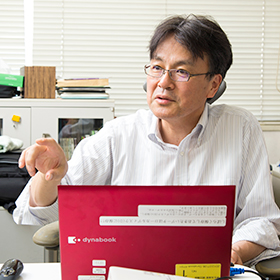 |
|
| |
| Let us walk you through his studies in a little more detail. |
| |
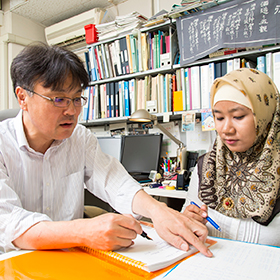 |
|
The study along the X axis concerning cytochrome c started with Sambongi’s undergraduate research tranining. “In the Izu Hot Spring area, thermophilic bacteria grow at 72℃. Such microorganisms are called ‘extremophiles.’ I was instructed to write a graduation thesis under this theme, which interested me very much. When the bacteria are cultured in our laboratory, their color changed to pink. This pink color indicated the presence of cytochrome c. Since that time, I have been attracted by cytochrome c, and have continued studying it for over 30 years.” Sambongi’s subsequent research concerning cytochrome c has focused on its environmental adaptability to temperature, and the molecular mechanism that provides stability through structure. |
|
| |
In the meantime, in his Y-axis research concerning the ATP synthetic enzyme, Sambongi demonstrated that the ATP synthetic enzyme produced ATP while rotating. This achievement subsequently led to the revision of textbooks. The video of the enzyme actually rotating is only possessed by Sambongi’s laboratory, and he shows this precious video in classes for freshman in the department. Only students at Hiroshima University are privileged to see this video.
In his Z axis research concerning fermentation, research and development activities are in progress in the field of fermentation technology for vegetables and fruits, in collaboration with OTAFUKU SAUCE CO., LTD., with which the School of Applied Biological Science signed a Memorandum of Understanding concerning Comprehensive Research Cooperation in July 2014. “The fermentation process is another way of producing ATP. By leveraging basic findings concerning fermentation in the food industry, we would like to utilize the basic findings to lead to beneficial food development in the future.” |
|
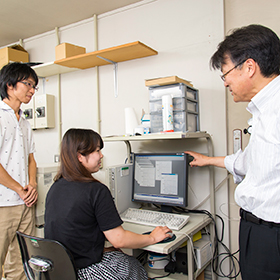 |
|
| |
 |
|
With respect to all these studies, Professor Sambongi considers that “researchers should travel from the basics to application, and then back again,” because individual basic studies contain possibilities for application. “Just as my studies originated in undergraduate research, it is my research “attitude” to spend my whole life resolving tasks that were rendered to me during my youth. I hope that young prospective researchers also examine their research attitude in such ways. On the other hand, the process of research does not proceed in a straight line. It sometimes travels from basics to application, and then back again. Still, I believe that changing themes will be eventually united into one, based on my three-dimensional view of research. I keep recognizing this principle, and this is one of the reasons why natural sciences are so interesting,” says Professor Sambongi with a smile. |
|
| |
| Scientific research is the process of translating nature; communicating it is extremely difficult. |
| |

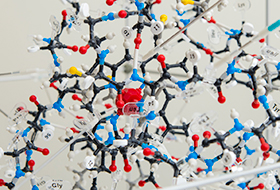

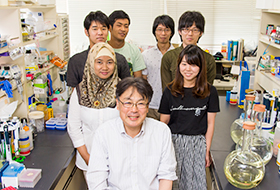
|
|
What is the most exciting thing about research for Professor Sambongi? To this question, he answered, “To communicate what our predecessors have taught us; scientists are persons who should represent unknown worlds in human language.”
“My mentor told me that both basics and application were exciting, and that I should do both. A professor in the laboratory next to ours said that, when we were faced with a problem, microbes would know the answer. Professor Kinichiro Sakaguchi, the mentor of my mentor, who developed the Sakaguchi flask, wrote that it was amusing that unknown worlds still remain. I would like to communicate my research to students, together with the lessons taught by our great predecessors. I suppose this is the most exciting point about research. Dialog with students is one of the things that I value the most,” says Professor Sambongi.
What outlook does he have toward the future? He had one outlook as a researcher. He again mentioned the three axes that comprised the entire academic system. “One of my policies is to continue my research as I have been doing. The natural science fields are the most interesting for me. In the meantime, I am planning to expand into the humanities and social sciences. In the humanities, I would like to have an overview of the position of my own studies in the history of chemistry. In the social sciences, I would like to continue studying how to incorporate the perspective of organizational theory into scientific research as an act of humans.
The other outlook that Professor Sambongi has is as an educator. “I would like to pursue an education style modeled after the Tekijuku School, which was opened by OGATA Kōan, a Japanese rangaku scholar in the old days. I would like to learn from his attitude of positioning himself in one academic system to improve himself, so that students at Hiroshima University can develop into internationally-minded educated persons.”
In conclusion, Professor Sambongi extended the following message to prospective researchers:
“When the educational process at a laboratory is divided into the bachelor step, master’s step, and doctorate step, it becomes clear what should be done in each step. In the bachelor step, it is important to participate in and learn all about performing basic experiments and writing a thesis. In the master’s step, the requirements are substantially upgraded, and students are supposed to learn to make an effort. In the doctorate step, your achievements are based on posting academic papers yourself. In this way, you should identify your own position, and focus on logical thinking, in order to lead the life of a researcher with few distractions. In the doctorate step onward, I would like to add another piece of advice from the same horizon as a peer researcher: that natural sciences never cease to intrigue researchers, and that research is a profession to objectively express the essence of nature in human language. Let us keep on endeavoring together, sincerely tackling the difficulty of communicating it.” |
|
| |
| Yoshihiro Sambongi |
| Microbial Biochemistry Laboratory
June 1, 1992 to February 28, 1995 Postdoctoral Fellow, Department of Biochemistry, University of Oxford
March 1, 1995 to January 31, 2002 Assistant, the Institute of Scientific and Industrial Research, Osaka University
February 1, 2002 to March 31, 2002 Associate Professor, School of Applied Biological Science, Hiroshima University
April 1, 2002 to September 30, 2011 Associate Professor, Graduate School of Biosphere Science, Hiroshima University
Since October 1, 2011 Professor, School of Applied Biological Science, Hiroshima University
Posted on Jan 26, 2017 |
| |











